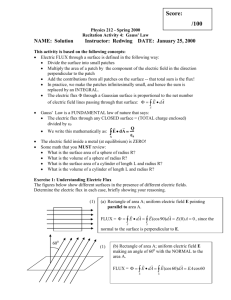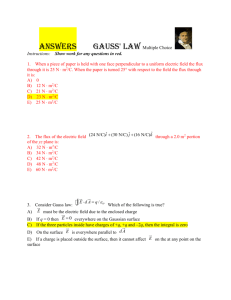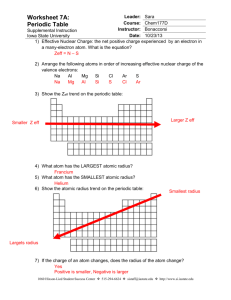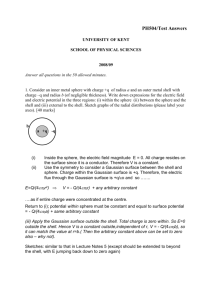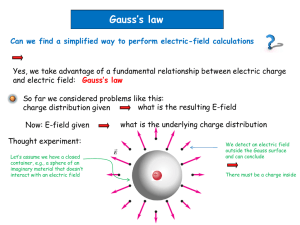Gauss` Law
advertisement
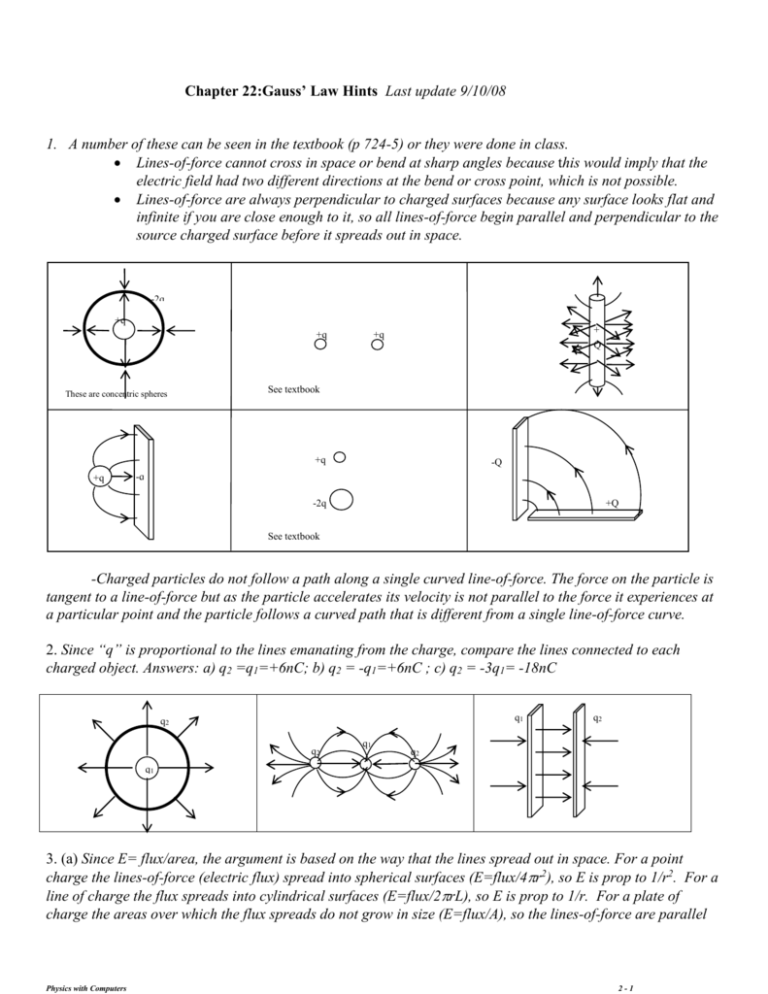
Chapter 22:Gauss’ Law Hints Last update 9/10/08 1. A number of these can be seen in the textbook (p 724-5) or they were done in class. Lines-of-force cannot cross in space or bend at sharp angles because this would imply that the electric field had two different directions at the bend or cross point, which is not possible. Lines-of-force are always perpendicular to charged surfaces because any surface looks flat and infinite if you are close enough to it, so all lines-of-force begin parallel and perpendicular to the source charged surface before it spreads out in space. -2q +q +q These are concentric spheres + Q +q See textbook +q +q -Q -q -2q +Q See textbook -Charged particles do not follow a path along a single curved line-of-force. The force on the particle is tangent to a line-of-force but as the particle accelerates its velocity is not parallel to the force it experiences at a particular point and the particle follows a curved path that is different from a single line-of-force curve. 2. Since “q” is proportional to the lines emanating from the charge, compare the lines connected to each charged object. Answers: a) q2 =q1=+6nC; b) q2 = -q1=+6nC ; c) q2 = -3q1= -18nC q1 q2 q2 q1 q2 q2 q1 3. (a) Since E= flux/area, the argument is based on the way that the lines spread out in space. For a point charge the lines-of-force (electric flux) spread into spherical surfaces (E=flux/4r2), so E is prop to 1/r2. For a line of charge the flux spreads into cylindrical surfaces (E=flux/2rL), so E is prop to 1/r. For a plate of charge the areas over which the flux spreads do not grow in size (E=flux/A), so the lines-of-force are parallel Physics with Computers 2-1 Experiment 2 and E is therefore uniform. The last two arguments are only true if you are away from the ends of the line or plate of charge. b)The electric field E can be defined as flux/area, since flux is the correct expression of the lines-of-force, one could say that E is the density of the lines-of-force. c) The main limitation is that the number of lines is finite whereas there is electric field at every point in space. 4. Illustration a) E b) E c) e) +q E= 200 N/C; diameter of hemisphere is 40 cm. Find the flux thru circular base of the hemisphere: = ER2 = +25 Nm2/C A B f) Find This was done in class: Through slanted surface and back vertical surface, = +12 Nm2/C, all others =0 Q=2 nC at the center of a Because the charge is at the center, it is cube with sides equal 60 cm. easier here to use Gauss’ law to determine the entire flux emanating from the charge and then divide by 6: side= 4kQ/6 = +38 Nm2/C q= 2 nC Because these are closed surfaces use Gauss’ law: A= 4k(+q-2q)= -226 Nm2/C; B= 4k(+q+3q)= +905 Nm2/C -2q +3q Given information E= 200 N/C; triangular dimensions are 30 cm,40 cm and 50 cm and the width is 20 cm. z y=a x=a E dA E is not uniform but it is given by the formula: E=Eoy/a (k^), where a and Eo are constants. The element of integration here is a strip parallel to the x-axis, a long and dy wide (dA=ady k). Then A= S EdA= Soa (Eoy/a) ady= Eoa2/2 5. (a) Charged spheres require spherical gaussians; rods require cylindrical guassians; and plates require a gaussian surface that have sides that are parallel and perpendicular to the plate. b) All these charge arrangements have fields that are not uniform enough for a simple gaussian surface. 6. Check your notes as some of these would have been done in class. Example a) 2-2 Point charge “q” Line-of- force illustration & gaussian surfaces E, dA Electric field expressions Graph of E from Gauss’ law vs. r Follow up... E=kq/r2 r^ Is a point charge likely to exist? No... Physics with Computers Back and Forth Motion b) Conducting sphere of charge Q with radius R dA for r<R for r>R E=0 E=kq/r2 r^ Ri <r<Ro r>Ro E=4k(rRi3/r2)/3 E= 4k(Ro3Ri3)/3r2 r>R E c) d) Non-conducting sphere with volume charge density with inner and outer radii Rin & Rout. Non-conducting sphere with nonuniform charge distribution =Ar and radius R dA E r<R What is the net charge? Q=AR4 dA E=kAr2r^ What happens to the field at a point outside if sphere shrinks to 0? Nothing.. Consider the special case of Rin=0. Ein =4kr/3 Eout =4kRo3/3r2 E=kA R4/r2 E 7. These would have been discussed in class: (a) Since all the charge is on the surface in a conductor, a gaussian surface inside enclosed no charge. 8. Some of these were done in class, so check your notes for hints on how to get the answers. Gaussian surfaces will be spheres. Example a) b) c) Line-of- force illustration & gaussian surfaces Electric field expressions Graph of E vs. r Inner metal sphere (+q) and outer shell of negligible thickness (-q) for r<a a to b E=0 E= kq/r2 r^ E=0 Point (+q) charge at the center of a solid, un-charged conducting shell (radius a to b) Non-conducting sphere with uniformly distributed (–q) surrounded by a thin conducting shell with (+2q) E= kq/r2 r^ E=0 Physics with Computers E= -kqr/R3 r^ for r>b Follow-up... inner = -q outer = 0 E= kq/r2 r^ inner = -q outer = +q E=-kq/r2 r^ E= kq/r2 r^ inner = +q outer = +q 2-3 Experiment 2 d) (a to b) E= kq1/r2 Metal sphere (q1, radius a) surrounded by a thick, metal shell with (q2, b to c) (b to c) E=0 E for r>c E= k(q1+q2)/r2 Varies.. inner = -q1 outer = (q1+q2) 9. Gaussian surfaces here will always be cylinders of arbitrary length and radius where the E field is being determined. Example a) b) c) d) Line-of- force illustration & gaussian surfaces Line of constant charge density dq/dL Conducting rod of charge Q, length L, and crosssectional radius R. Line of charge with density surrounded by cylindrical shell with - density and radius R Non-conducting rod with uniform charge distribution =dQ/dV and radius R Electric field expressions, measured from the center of the rod. E=2k/r r^ for r<R for r>R E=0 E=2kQ/Lr for r<R for r>R E=2k/r r^ E=0 r<R E=2kr r>R E=2kR2/r Graph of E vs r Follow-up... Is it possible to have a line of charge? No… E=2k/r E=4kR/r = -/2R on the inside surface and “0” on the outside surface You would have to integrate to get qin: qin = SCr(2r ldr)= C2 lr3/3 10. For a numerical example, consider a cylindrical conductor of length 20 cm and diameter 1 cm. A proton 1 cm above the surface of the cylinder orbits the cylinder with a speed of 106 m/s. Determine: (a) the linear charge density of the cylinder, and (b) the net charge of the cylinder. What if the proton’s orbit were 2 cm? This requires that you review circular motion. The proton’s centripetal force (mv2/r) is provided here by the electric force from the field (Eq). The E field can then be related to the charge density of the rod. My answers: a) -0.58C/m; b) -0.116 C; c) The radius of the orbit doesn’t change any of the answers because they are independent of “r”. 11. Gaussian surfaces can be cylinders of arbitrary height and crossection. Example 2-4 Line-of- force illustration & gaussian surfaces Electric field expressions, measured from the center of the plate. Graph of E vs. y Follow-up... Physics with Computers Back and Forth Motion a) b) c) Non-conducting sheet of charge with charge Q and area A Conducting sheet of charge with charge Q, surface area A, and thickness d. Non-conducting slab of area A, thickness d, with charge Q uniformly distributed. E=2kQ a =dQ/dA =Q/A E a a E a y E a for y< d/2 E=0 for y> d/2 E=2kQ ’=dq/dA=Q/2A for y< d/2 E=Qydo; for y> d/2 E=Qo E=yo; Where y is measured from center of slab. a 12. In 11a above, Ea = /2o . In 11b above, Ea =’/o . These two expressions appear different because = 2’. But the fields must be equal since the overall charge density is the same. 13. Seen from the outside the slab has an overall area charge density Q/A=, the same as for the sheet of charge of negligible thickness. This is reasonable because outside the slab, the thickness is irrelevant. In all cases in problem 11 the outside field depends only on the overall charge density. 14. The most uniform electric fields are generated by two or more sheets of charge parallel to each other. Example Line-of- force illustration & gaussian surfaces Electric field expressions, in between and outside the plates outside between E=0 E=Qo b) Two conducting sheets of area A with equal and opposite charges +Q & -Q c) Two conducting sheets of area A with charges +Q & -2Q E=Qo; Three sheets of area A with charges +Q, +Q, and -Q E=Qo; E=Qo; Away from the plates From 1st to 2nd plate. d) Toward the plates E= 3Qo; from + to - E=3Qo from 2nd to 3rd plate. Physics with Computers Graph of E vs. Follow-up... x, form the left-most plate. E= o -Q/2 and +3Q/2 on +plate and -3Q/2 and –Q/2 on – plate. +Q/2 & +Q/2 on 1st plate; -Q/2 and +3Q/2 on 2nd plate; -3Q/2& +Q/2 on 3rd plate. 2-5 Experiment 2 -Note: From afar the net effect of many plates is that of one plate with a net charge, the field must emanate equally in both direction because of the symmetry of space so the outside fields must be equal and opposite. 15. This is numerical version of 14b. If you follow similar procedures you can get the formulas for the fields outside and in between the plates. Use 2 Gaussian surfaces to relate the field between the plates and the field outside the plates. Use the fact that by symmetry the fields outside must be equal and opposite. Answers: a) Eo=1.2 x106 N/C & Ei=4.2 x106 N/C; b) o=10.6 C/m2 & i=36.9 C/m2; c) qo=0.85 C & Ei=2.95 C; d) Determine the acceleration of the electron and use the appropriate kinematics formula. q,m 16. As a review of simple harmonic motion consider this problem. A small object of mass m and charge q is attached by a thread of length l to a large, flat, non-conducting sheet of l charge with area charge density and same sign as q. If the object is displaced slightly from equilibrium, show that it will undergo SHM with a period of T= 2(2oml/q)1/2. q 1/2 Solution: This is basically a simple pendulum. Recall that the period of a simple pendulum is T=2(l/g) . Here the “g” is by analogy the acceleration due to the electric field, which is a=F/m=Eq/m. Finally the electric field here is due to a flat sheet of charge so that E=o. After substituting you get the expression given. 17. Gauss’ law can also be applied to gravitation by defining analogous quantities to those in electricity. a) Show that the gravitational acceleration “g” can be defined as the “gravitational field” at a point. b) Define “gravitational flux” and use it to express Gauss’ law for gravity. c) Use Gauss’s law to prove that the gravitational field outside a planet with uniform mass density is the same as if the mass were concentrated at the center. (Newton had to use calculus to prove this, since he didn’t have Gauss’ law). a) By analogy to the electric field (F/q) the gravitational field “Eg” should be F/m. Since F=GMm/r2, Eg= GM/r2 which is “g, the acceleration due to gravity. b) Gravitational flux should be g= Eg dA and Gauss’ law of gravity should be Eg dA= 4GMinside. c) You can use Gauss’ law here the same way we used it to show that sphere of uniform charge had the same field as a point charge outside. 18. After J.J. Thomson discovered that atoms contained negative particles (now called electrons). He postulated the first atomic model that consisted of electrons distributed throughout a uniform ball of positive charged material (protons and the nucleus had not yet been discovered). He described this model as plums in a pudding hence it came to be known as the “plum-pudding” model of the atom. In this model the electrons did not “orbit” but were located at “equilibrium positions” inside the atom. a) Explain why, in the hydrogen atom, the equilibrium position of the electron is at the center of the mass of positive matter. That’s where the field is zero… b) Show that if the electron is displaced by a small amount from the center, the resulting motion is simple harmonic. The field from the positive distribution depends on “r” so there would be a restoring force proportional to the position of the electron, suggesting a SHM case… c) In Thomson’s time it was known that atoms emit light waves when excited. Thomson postulated that this was caused by the electron vibrating back and forth. What would be the size of the hydrogen atom 2-6 Physics with Computers Back and Forth Motion in this model to produce light of frequency 4.5 x 1014 Hz? Compare to the known size of the hydrogen atom of about 10-10 m. Hint: Use the period derived from the SHM in (b). d) If the electron were displaced from equilibrium by a distance greater than the radius of the positive ball of charge, would the resulting motion still be simple harmonic? Explain. No…the force becomes inverse squared with distance… e) Consider a Thomson model of the Helium atom, with two electrons and a positive spherical mass of charge +2e of radius R. How far from the center must the two electrons have to be for the atom for be stable? Hint: Locate the point where the electric field from the +charge mass and the other –electron would cancel. 19. Thomson’s model of the atom was proven incorrect when Rutherford discovered that the positive “stuff” (what we now call the protons) was concentrated inside a tiny region of the atom (about 10-14 m in diameter). The modern “quantum model” describes the hydrogen atom as consisting of a “point” positive +e charge at the center and the electron “smeared out” over the volume surrounding the nucleus. The electron charge density is Q given by the equation: (r ) 3 e 2 r / ao , where ao= 5.3 x 10-11 m and is called the Bohr radius, and Q is ao the elementary charge “e”= 1.6 x 10-19C. This is a very challenging problem. a) Find the total amount of charge within a volume of radius “r”. Show that as rinfinity, the net enclosed charge is zero. Explain that result. The first thing is to find the amount of charge due to the “negative cloud” created by the electron. This requires that you integrate the given density function over a sphere of radius “r” within the volume. q(r)= dV= r2dr)= (-Q/ao3) e-2r/a r2dr)=…. The solution can be found in a “Table of Integrals”, in general x2e-bx dx= -(1/b3)(b2x2+ 2bx+2)e-bx b) Find the electric field caused by the hydrogen atom as a function of r. c) Graph the electric field vs. r. Physics with Computers 2-7



